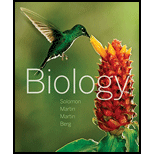
Concept explainers
Test Your Understanding
1. Which of the following is not a shared derived character of echinoderms? (a) water vascular system (b) notochord (c) tube feet (d) pentaradial symmetry in adult (e) endoskeleton of calcium carbonate plates and spines
Introduction: Animal phylogeny is the rapidly changing field for biologists. Even if the members of the animal kingdom are incredibly diverse, there are various animals sharing certain features that differentiate them from other organisms of the kingdom. The most highly derived body plan among all animals of the animal kingdom is echinoderm. Echinoderms are the animals that have no terrestrial or freshwater representatives and these animals belong to marine habitat.
Answer to Problem 1TYU
Correct answer: The presence of notochord is not a shared derived character of echinoderms. Hence, the correct answer is option (b).
Explanation of Solution
Reason for the correct answer:
The shared derived characters of echinoderms are as follows:
- Presence of water vascular system.
- Presence of numerous tiny tube feet.
- Presence of endoskeleton, ciliated epidermis, and thin covering.
- The adults of echinoderms exhibit pentaradial symmetry.
The presence of notochord is one of the characters of chordates. Some of the chordates have notochord during some time of their developmental cycle, whereas some chordates have notochord during their whole life time like vertebrates. It is not the shared derived character of echinoderms.
Option (b) is given as “notochord”.
The presence of notochord is not a shared derived character of echinoderms. Hence, the correct answer is option (b).
Reasons for the incorrect answers:
Option (a) is given as “water vascular system”.
The unique structural derived character of echinoderms is the presence of a network of fluid-filled canals and chambers called water vascular system. Hence, option (a) is incorrect.
Option (c) is given as “tube feet”.
The presence of numerous tiny tube feet is one the structural unique character of echinoderms. Hence, option (c) is incorrect.
Option (d) is given as “pentaradial symmetry in adult”.
The echinoderm adult exhibits pentaradial symmetry and the larval form exhibits bilateral symmetry. Hence, option (d) is incorrect.
Option (e) is given as “endoskeleton of calcium carbonate plates and spines”.
The presence of endoskeleton, ciliated epidermis, and thin covering is the unique feature of echinoderm. The endoskeleton of echinoderms consists of calcium carbonate (CaCO3) spines and plates. Hence, option (e) is incorrect.
Hence, options (a), (c), (d), and (e) are incorrect.
The presence of notochord is not a shared derived character of echinoderms.
Want to see more full solutions like this?
Chapter 32 Solutions
Biology (MindTap Course List)
- Noggin mutation: The mouse, one of the phenotypic consequences of Noggin mutationis mispatterning of the spinal cord, in the posterior region of the mouse embryo, suchthat in the hindlimb region the more ventral fates are lost, and the dorsal Pax3 domain isexpanded. (this experiment is not in the lectures).a. Hypothesis for why: What would be your hypothesis for why the ventral fatesare lost and dorsal fates expanded? Include in your answer the words notochord,BMP, SHH and either (or both of) surface ectoderm or lateral plate mesodermarrow_forwardNot part of a graded assignment, from a past midtermarrow_forwardNot part of a graded assignment, from a past midtermarrow_forward
- please helparrow_forwardWhat does the heavy dark line along collecting duct tell us about water reabsorption in this individual at this time? What does the heavy dark line along collecting duct tell us about ADH secretion in this individual at this time?arrow_forwardBiology grade 10 study guidearrow_forward
 Biology (MindTap Course List)BiologyISBN:9781337392938Author:Eldra Solomon, Charles Martin, Diana W. Martin, Linda R. BergPublisher:Cengage Learning
Biology (MindTap Course List)BiologyISBN:9781337392938Author:Eldra Solomon, Charles Martin, Diana W. Martin, Linda R. BergPublisher:Cengage Learning Biology: The Dynamic Science (MindTap Course List)BiologyISBN:9781305389892Author:Peter J. Russell, Paul E. Hertz, Beverly McMillanPublisher:Cengage Learning
Biology: The Dynamic Science (MindTap Course List)BiologyISBN:9781305389892Author:Peter J. Russell, Paul E. Hertz, Beverly McMillanPublisher:Cengage Learning Biology 2eBiologyISBN:9781947172517Author:Matthew Douglas, Jung Choi, Mary Ann ClarkPublisher:OpenStax
Biology 2eBiologyISBN:9781947172517Author:Matthew Douglas, Jung Choi, Mary Ann ClarkPublisher:OpenStax
 Biology: The Unity and Diversity of Life (MindTap...BiologyISBN:9781337408332Author:Cecie Starr, Ralph Taggart, Christine Evers, Lisa StarrPublisher:Cengage Learning
Biology: The Unity and Diversity of Life (MindTap...BiologyISBN:9781337408332Author:Cecie Starr, Ralph Taggart, Christine Evers, Lisa StarrPublisher:Cengage Learning Biology: The Unity and Diversity of Life (MindTap...BiologyISBN:9781305073951Author:Cecie Starr, Ralph Taggart, Christine Evers, Lisa StarrPublisher:Cengage Learning
Biology: The Unity and Diversity of Life (MindTap...BiologyISBN:9781305073951Author:Cecie Starr, Ralph Taggart, Christine Evers, Lisa StarrPublisher:Cengage Learning





